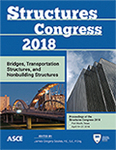Structures Congress 2018
Recommendations for Improving Fire Performance of Steel Bridge Girders
Publication: Structures Congress 2018: Bridges, Transportation Structures, and Nonbuilding Structures
ABSTRACT
Infrastructure risk due to fire has been well documented. In particular, bridges in the urban environment are susceptible due to low overhead clearances on overpasses, existing simple spans with no redundancy, narrow lane widths, and general alignment congestion. Although the risk is significant, the current AASHTO Bridge Design Specification does not include provisions for design due to fire conditions. As such, this paper considers alternatives for improving the fire resistance of steel bridges using both traditional and non-traditional fire protection methods. In this paper, a total of eight parameters are investigated: (1) global section factor (W/D ratio) of bridge girder cross-section; (2) thickness of the flange; (3) thickness of the web; (4) steel material specification; (5) concrete slab width; (6) concrete slab thickness; (7) thickness of intumescent paint; and (8) thickness of SFRM. It is shown that the temperature domain performance can be significantly increased by (1), (3), (7), and (8) while the other parameters are less effective. The recommendations from this research can be readily implemented in both bridge design and retrofit scenarios.
Get full access to this article
View all available purchase options and get full access to this chapter.
ACKNOWLEDGEMENTS
The research presented in this paper was supported by the University Transportation Research Center (UTRC) through Grant #49198-19-28.
REFERENCES
Alos-Moya, J., Paya-Zafortezo, I., Garlock, M.E.M., Loma-Ossorio, E., Schiffner, D., and Hospitaler, A. (2014). “Analysis of a Bridge Failure Due to Fire Using Computational Fluid Dynamics and Finite Element Models.” Engineering Structures, 68, 96–110.
American Society of Civil Engineers (2016). Minimum Design Loads for Buildings and Other Structures (ASCE/SEI 7-16), Reston, Virginia; 2016.
ASTM International (2016). ASTM E119: Standard Test Methods for Fire Tests of Building Construction and Materials. West Conshohocken, PA; 2016.
ASTM International (2016). ASTM E1529: Standard Test Methods for Determining Effects of Large Hydrocarbon Pool Fires on Structural Members and Assemblies. West Conshohocken, PA; 2016.
Bentz, D. & Prasad, K. (2007). Thermal Performance of Fire Resistive Materials I. Characterization with Respect to Thermal Performance Models. NISTIR 7401. NIST.
Bergman, T. L., Adrienne, S. L., Incropera, F. P., DeWitt, D. P. (2011). Fundamentals of Heat and Mass Transfer, 7th edition, Wiley, Hoboken, NJ.
Buchanan, A. H., A. K. Abu. (2017). Structural Design for Fire Safety, 2nd Edition, Wiley, West Sussex, UK.
Cedeno, G., Varma, A., and Gore, J. (2011) Predicting the Standard Fire Behavior of Composite Steel Beams. Composite Construction in Steel and Concrete VI: pp. 642–656.
Cor-Ten™ Product Literature (2014), Nippon Steel & Sumitomo Metal Corporation. http://www.nssmc.com/product/catalog_download/pdf/A006en.pdf
Dassault Systèmes. (2013). “Abaqus 6.13 Online Documentation”. Vélizy-Villacoublay, France.
Jun Ding, Guo-Qiang Li, Y. Sakumoto, Parametric studies on fire resistance of fire-resistant steel members, Journal of Constructional Steel Research, Volume 60, Issue 7, 2004, Pages 1007-1027, ISSN, https://doi.org/10.1016/j.jcsr.2003.09.007.
European Committee for Standardization (CEN). (2002). “Actions on structures. Part 1.2: General action—Action on structures exposed to fire.” Eurocode 1, Brussels, Belgium.
European Committee for Standardization (CEN). (2004). “Design of concrete structures. Part 1.2: General rules—Structural fire design.” Eurocode 2, Brussels, Belgium.
European Committee for Standardization (CEN). (2005). “Design of steel structures. Part 1.2: General rules—Structural fire design.” Eurocode 3, Brussels, Belgium
Garlock, M., Glaasman, J., and Labbouz, S. (2013) “Elevated Temperature Properties of A588 Weathering Steel.” CAIT – Rutgers, Report CAIT-UTC-021
Garlock, M., Ignacio Paya-Zaforteza, Venkatesh Kodur, Li Gu, Fire hazard in bridges: Review, assessment and repair strategies, Engineering Structures, Volume 35, 2012, Pages 89-98, ISSN, https://doi.org/10.1016/j.engstruct.2011.11.002.
Gong, X., and Agrawal, A. K. (2015). “Numerical Simulation of Fire Damage to a Long-Span Truss Bridge.” J. Bridge Eng. https://doi.org/10.1061/(ASCE)BE.1943-5592.0000707
Gong, X., and Agrawal, A. K. (2016). “Safety of Cable-Supported Bridges during Fire Hazards”. J. Bridge Eng. https://doi.org/10.1061/(ASCE)BE.1943-5592.0000870
Kodur, V., Aziz, E., and Dwaikat, M. (2013). ”Evaluating Fire Resistance of Steel Girders in Bridges.” J. Bridge Eng., 18(7), 633–643.
Kodur, V., Dwaikat, M., Fike, R. (2010). “High-Temperature Properties of Steel for Fire Resistance Modeling of Structures.” J. Mat. in Civil Eng. https://doi.org/10.1061/(ASCE)MT.1943-5533.0000041
Krishnamoorthy, R.R., & Bailey, C. (2009). Temperature distribution of intumescent coated steel frame connection at elevated temperature. Manchester.
Lee, George C., Satish B. Mohan, Chao Huang, & Bastam N. Fard. (2013) A Study of U.S. Bridge Failures (1980-2012). Tech. no. 13-0008. U.S. Department of Transportation Federal Highway Administration. University at Buffalo, State University of New York: MCEER <https://mceer.buffalo.edu/pdf/report/13-0008.pdf>.
Mills, K.C., Su, Y., Li, Z., and Brooks, R.F. (2004). “Equations for the Calculation of the Thermo-physical Properties of Stainless Steel”. ISIJ International. Vol. 44 (2004) No. 10 P 1661-1668. https://doi.org/10.2355/isijinternational.44.1661
Mizutani, Y., Yoshii, K., Chijiiwa, R., Ishibashi, K., Watanabe, Y., and Yoshida, Y. (2004): Nippon Steel Technical Report: “590MPa Class Fire-Resistant Steel for Building Structural Use,” Report No. 90, July 2004.
Wainman, D.E., and Kirby, B.R. (1987). “Compendium of UK Standard Fire Test Data, Unprotected Structural Steel – 1,” British Steel Corporation Ref. No. RS/RSC/S10328/1/98/B, Swinden Laboratories, Rotherdam.
Wright, W., Lattimer, B., Woodworth, M., Nahid, M., and Sotelino, E. (2013). “Highway Bridge Fire Hazard Assesment, Draft Final Report.” Virginia Polytechnic Institute and State University. TRB Project No. 12-85. Blacksburg, VA.
Information & Authors
Information
Published In
Structures Congress 2018: Bridges, Transportation Structures, and Nonbuilding Structures
Pages: 48 - 64
Editor: James Gregory Soules, CB&I
ISBN (Online): 978-0-7844-8133-2
Copyright
© 2018 American Society of Civil Engineers.
History
Published online: Apr 17, 2018
Published in print: Apr 17, 2018
Authors
Metrics & Citations
Metrics
Citations
Download citation
If you have the appropriate software installed, you can download article citation data to the citation manager of your choice. Simply select your manager software from the list below and click Download.
